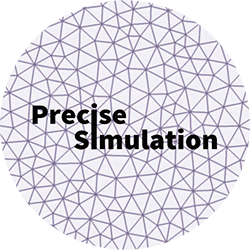
|
FEATool Multiphysics
v1.17.5
Finite Element Analysis Toolbox
|

|
FEATool Multiphysics
v1.17.5
Finite Element Analysis Toolbox
|
EX_LINEARELASTICITY1 Example for solid stress-strain on a cube.
[ FEA, OUT ] = EX_LINEARELASTICITY1( VARARGIN ) Example to calculate displacements and stresses for a cube stretched in axis-aligned directions.
Accepts the following property/value pairs.
Input Value/{Default} Description
-----------------------------------------------------------------------------------
E scalar {1} Modulus of elasticity
nu scalar {0.3} Poissons ratio
force scalar {1} Load force
idir scalar 1/{2,3} Stress direction
igrid scalar 1/{0} Cell type (0=quadrilaterals, 1=triangles)
hmax scalar {0.1} Max grid cell size
sfun string {sflag1} Shape function for displacements
iplot scalar 0/{1} Plot solution (=1)
.
Output Value/(Size) Description
-----------------------------------------------------------------------------------
fea struct Problem definition struct
out struct Output struct
cOptDef = { 'E', 1;
'nu', 0.3;
'force', 1;
'idir', 1;
'igrid', 0;
'hmax', 0.1;
'sfun', 'sflag1';
'iplot', 1;
'psecheck', 0;
'tol', sqrt(eps);
'fid', 1 };
[got,opt] = parseopt(cOptDef,varargin{:});
fid = opt.fid;
% Geometry definition.
fea.geom.objects = { gobj_block() };
fea.sdim = { 'x' 'y' 'z' }; % Coordinate names.
% Grid generation.
switch opt.igrid
case -1
fea.grid = blockgrid( round(1/opt.hmax) );
fea.grid = hex2tet( fea.grid );
case 0
fea.grid = blockgrid( round(1/opt.hmax) );
case 1
fea.grid = gridgen( fea, 'hmax', opt.hmax, 'fid', fid );
end
n_bdr = max(fea.grid.b(3,:)); % Number of boundaries.
% Boundary conditions.
s = sign(opt.idir); opt.idir = abs(opt.idir);
dtol = opt.hmax;
fixbdr = findbdr( fea, [fea.sdim{opt.idir},'<',num2str(dtol)] ); % "Right" boundary number.
forcebdr = findbdr( fea, [fea.sdim{opt.idir},'>',num2str(1-dtol)] ); % "Left" boundary number.
% Problem definition.
fea = addphys(fea,@linearelasticity);
fea.phys.el.eqn.coef{1,end} = { opt.nu };
fea.phys.el.eqn.coef{2,end} = { opt.E };
fea.phys.el.sfun = { opt.sfun opt.sfun opt.sfun };
% Fix first boundary (set idir displacement to zero, Dirichlet BC).
bctype = mat2cell( zeros(3,n_bdr), [1 1 1], ones(1,n_bdr) );
bctype{opt.idir,fixbdr} = 1;
fea.phys.el.bdr.coef{1,5} = bctype;
% Apply load to second opposite boundary.
bccoef = mat2cell( zeros(3,n_bdr), [1 1 1], ones(1,n_bdr) );
bccoef{opt.idir,forcebdr} = s*opt.force;
fea.phys.el.bdr.coef{1,end} = bccoef;
% Parse and solve problem.
fea = parsephys( fea );
fea = parseprob( fea );
fea.sol.u = solvestat( fea, 'fid', fid, 'icub', 1+str2num(strrep(opt.sfun,'sflag','')) );
% Postprocessing.
if( opt.iplot>0 )
figure
postplot( fea, 'surfexpr', fea.dvar{opt.idir} )
title( [fea.sdim{opt.idir},'-displacement'] )
end
% Error checking.
x = linspace(0,1,7);
x = x(2:end-1)';
[x,y,z] = ndgrid(x,x,x);
p = [x(:) y(:) z(:)]';
ui = evalexpr( fea.dvar{opt.idir}, p, fea );
ui_ref = s*p(opt.idir,:)';
out.ui_err = norm( ui - ui_ref );
out.pserr = [];
out.peerr = [];
for i=1:6
out.serr(i) = norm( abs( evalexpr( fea.phys.el.eqn.vars{5+i, end}, p, fea ) - s*(i==opt.idir) ) );
out.eerr(i) = norm( abs( evalexpr( fea.phys.el.eqn.vars{14+i,end}, p, fea ) - s*(i==opt.idir) + s*0.3*(i<=3 & i~=opt.idir)) ) ;
if( opt.psecheck && i<=3 )
out.pserr(i) = norm( abs( evalexpr( fea.phys.el.eqn.vars{11+i,end}, p, fea ) - (i==1) ) );
out.peerr(i) = norm( abs( evalexpr( fea.phys.el.eqn.vars{20+i,end}, p, fea ) - (i==1) + 0.3*(i~=1) ) );
end
end
out.serr = [ out.serr norm( abs( evalexpr( fea.phys.el.eqn.vars{1, end}, p, fea ) - 1 ) ) ];
out.pass = all( [out.ui_err out.serr out.eerr out.pserr out.peerr] < opt.tol );
if ( nargout==0 )
clear fea out
end